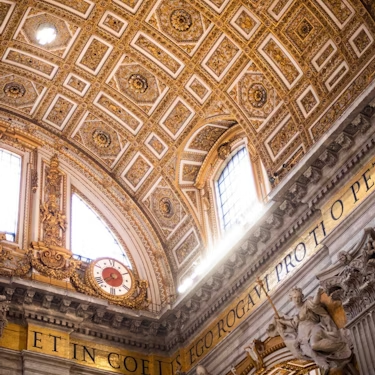More about: 6 Days in Rome
Rome promises adventure for as long as you go. However, five days is the exact measure of a perfect trip to Rome: you can stroll leisurely through its streets, see all its sights and some secret corners, and take your time to really enjoy the city instead of rushing from one place to another.
It's easy to make a five-day itinerary in Rome in which every day is a must, but only if you know what to see each day. Spending time in the Eternal City is something that pays off in spades, and in the following lines I'll tell you why.
1. Day one: Rome's main monuments and a stroll through the Jewish Quarter
In my experience, starting a trip to Rome with the Colosseum and the Roman Forum is a spectacular way to get your first glimpse of the city's grandest side, that of its imperial monuments and ruins.
Visit the Colosseum
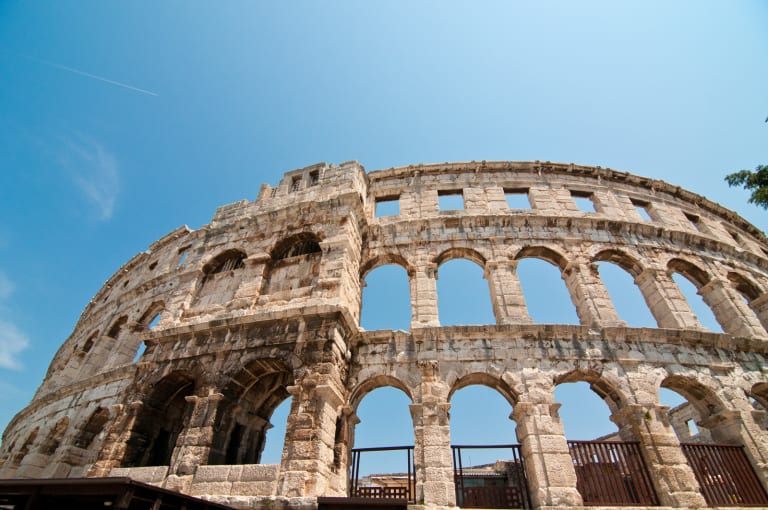
Regardless of how long you'll be in Rome, it's best to find out how to buy your tickets for the Colosseum in advance, which allows you to skip the queue at the ticket office. You will have to wait in line to get in, as this monument receives a huge influx of people from the time it opens until it closes. Therefore, it is best to go as early as possible.
Another option is to take a guided tour of the Colosseum, where you don't have to wait in line to enter the monument and you will be narrated by a guide specialised in Ancient History. Please note that if you have purchased the Roma Pass you must book your ticket for the Colosseum and it is best to do so as soon as possible to ensure the first time slot in the morning.
Useful information
- How to get there: by metro to the Colosseo stop (metro line B). More info at How to get to the Colosseum in Rome
- Opening hours: 8.30 am to 7 pm. Closed on 25 December and 1 January.
- Tickets: You can book in advance to avoid queues at the ticket office.
See the Roman Forum
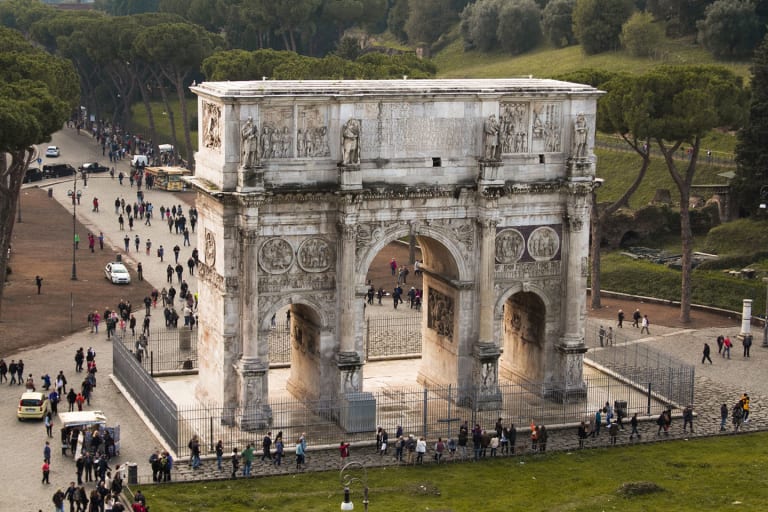
Next to the Colosseum, there is a huge archaeological site known as the Roman Forum. This was the centre of Ancient Rome, where the main buildings of political life were located as well as temples and markets, and a must-see. So don't hesitate and book a visit to the Forum.
The Roman Forum is on top of the Palatine Hill, and the main entrance is very close to the Colosseum. You can also enter through the Via di San Gregorio entrance. If you don't feel like walking or are not in a hurry, just go to the main entrance, where you can see the impressive Arch of Constantine, almost 1,700 years old.
Once inside the Roman Forum, keep your eyes peeled for the Arch of Titus, which was built to celebrate the conquest of Jerusalem, the Basilica of Maxentius, a public meeting place that you may recognise as an inspiration for other Renaissance-era buildings, and the Temples of Antoninus and Faustina and of Vesta.
Stop for lunch

If you're getting hungry, which can happen with literally every step you take in Rome, I recommend booking a food tour of Rome where you can enjoy some of Italy's top culinary delights.
Alternatively, head to the Taverna dei Quaranta, whose cosy atmosphere makes it a great place to enjoy a good meal and relax. With its vaulted ceilings and checkered tablecloths, the slightly retro style of this place goes hand in hand with exquisite traditional food. It is located at Via Claudia, 24.
Walk around Piazza Venezia and the Campidoglio
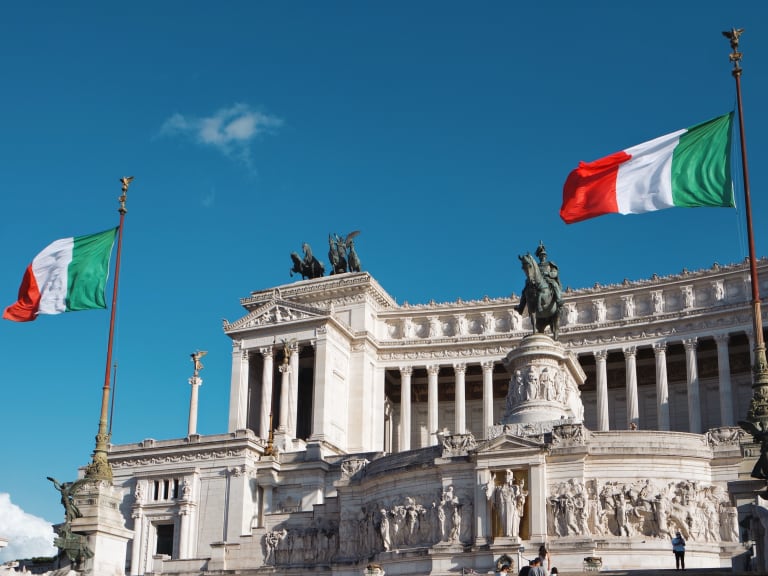
In the early afternoon, I recommend you book a tour of Rome's fountains and squares to discover the most beautiful corners of Rome.
You can also visit Piazza Venezia, dominated by the monument to Victor Emmanuel II (also known as the Altar of the Fatherland). There you can climb up to what is known as the Terrace of the Quadrigas, or popularly 'Roma dal Cielo', and enjoy beautiful views of the square itself, the Roman Forum and the Colosseum. The entrance fee is 7 € for adults and 3.5 € for children and teenagers between 10 and 18 years old, so this is a totally optional but recommended experience.
Afterwards, I advise you to go up the hill of the Campidoglio and sit in the square of the same name. Its oval structure, the statue of the emperor and thinker Marcus Aurelius in the centre, and the beautiful buildings surrounding it make it, in my opinion, one of the most beautiful squares in Rome, so take your time to enjoy it. From its vantage point there are also beautiful views of the Roman Forum.
Delve into the Jewish Quarter
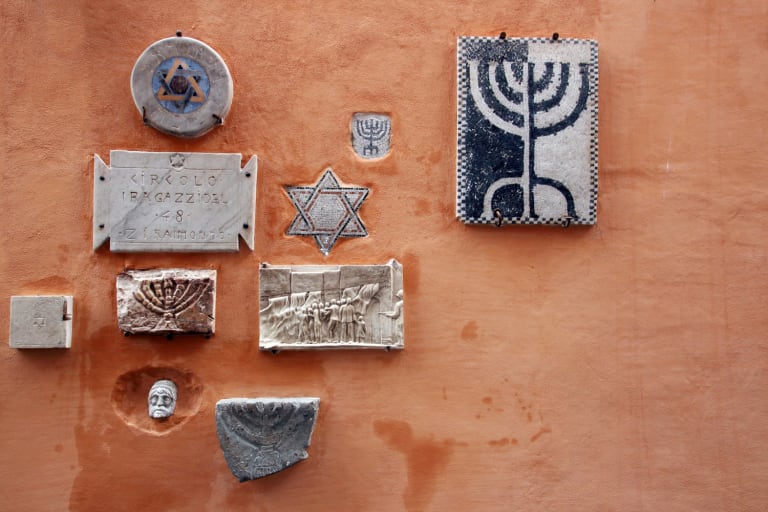
After marvelling at the greatest monuments of Ancient Rome, take a look at a very different side of the city: the Jewish quarter or ghetto of Rome.
If you book a tour of the Jewish Quarter, you will get to know it and you will see that it is a very quiet place where it is ideal to get lost in its narrow streets: located next to the Tiber, peace reigns in its corners and you will magically forget that you are actually very close to the crowded Colosseum.
On your stroll through the Jewish quarter, visit the Great Synagogue of Rome (which you can only visit inside on an official tour), pass by the Portico of Octavia, which in ancient times housed a library and several temples, and sit in Piazza Mattei to enjoy the murmur of water from the enchanting Fountain of the Turtles.
Discover the Piazza della Bocca della Verità
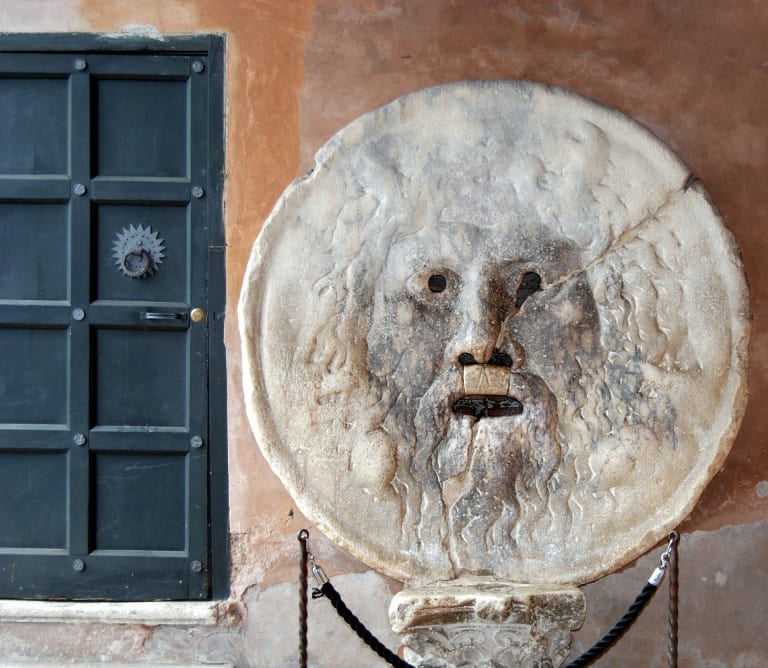
The Piazza della Bocca della Verità, a short walk from the Jewish Quarter, is home to one of Rome's most popular curiosities, inside the portico of the beautiful medieval church of Santa Maria in Cosmedin. It is, of course, La Bocca della Verità, a marble carving depicting the face of a man with his mouth open.
If you've seen Audrey Hepburn's Vacation in Rome, you'll remember the scene where she instantly reaches in. According to legend, the Bocca della Verità knows how to recognise liars, so she bites off the hand of anyone who has stuck it in her mouth. In the same square you can also see other minor points of interest, such as the Temple of Hercules, the Temple of Portunus and the Arch of Janus. This will be one of the places you will visit on your tour of Rome's fountains and squares.
Afterwards, you can take a walk and return to the Jewish quarter for dinner and a drink. I recommend you try the famous Jewish artichoke dish served in most of the restaurants in the area, but if you want a recommendation, go to Giggetto al Portico d'Ottavia on Via del Portico D'Ottavia 21/a-22, where they serve this traditional recipe as well as a delicious pasta.
Day 2: Walk around Piazza Navona, the Pantheon and the streets of central Rome
On the second day you will continue to see the city centre and other important monuments. I recommend you to take a guided tour to be told about the historical details that the most emblematic places of the city have. I'll tell you what they are:
Let yourself be dazzled by the Pantheon
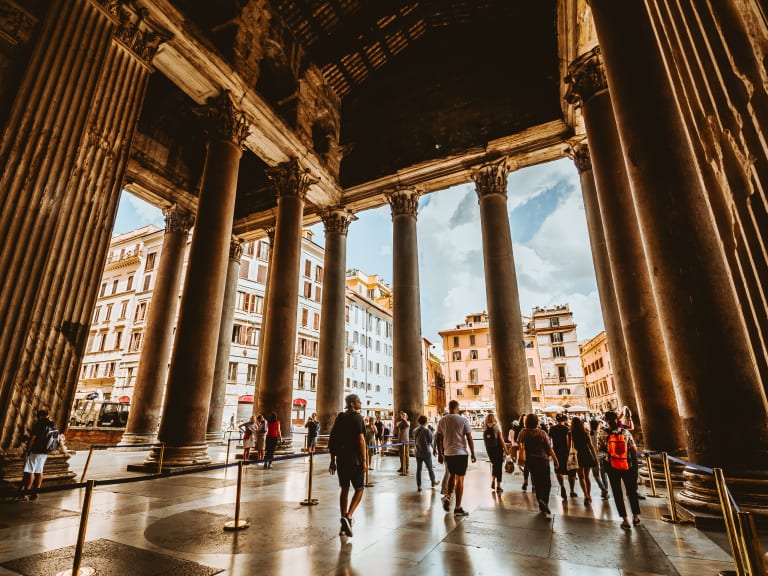
The Piazza della Rotonda is home to one of the most interesting and beautiful places in the whole city: the Pantheon of Agrippa, also known as the church of Santa Maria Rotonda. In the 7th century, what had been built as a temple dedicated to the Roman deities was converted into a Catholic church, and so the best-preserved building of Ancient Rome has survived to this day.
The Pantheon is an architectural marvel, and inside you will feel as if you have been transported to another world. The first instinct on entering is to look up and marvel at the dome and the round opening at the top of it, an oculus that lets in sunlight and creates a magical atmosphere that fills the whole space. The opulence of the Pantheon's walls includes monumental tombs of Italian kings and the artist Raphael, as well as carefully crafted mosaics and sculptures that glow with a special light.
If you want to learn all about the history behind it, book a guided tour of the Pantheon. On the way out, I recommend a walk around the outside of the building to really understand how incredible the structure of this temple is.
Stroll through Rome's most beautiful squares
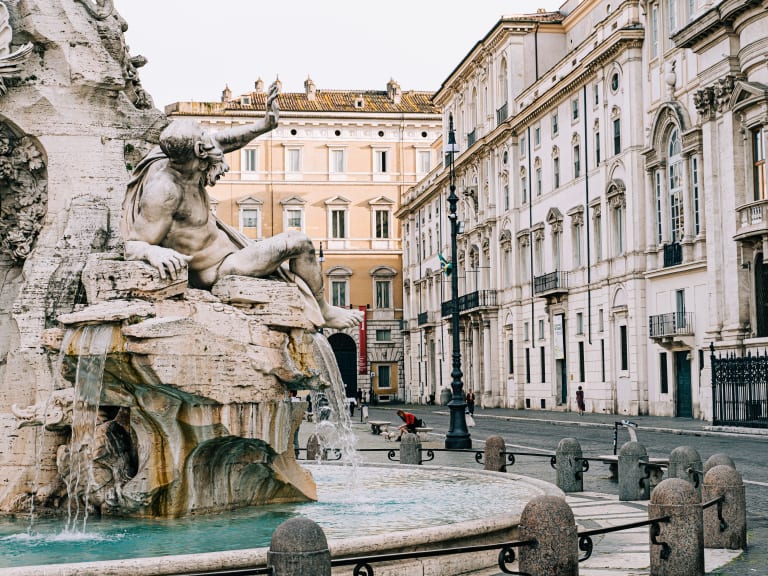
After visiting the Pantheon, take a stroll around the surrounding squares. The most beautiful are Piazza di Petra, which has beautiful ruins and a lively atmosphere, Piazza della Minerva and Piazza Sant'Eustachio, famous among other things for Sant'Eustachio Il Caffè, a coffee shop that serves one of the best espressos in Rome.
Piazza Navona is one of the most famous squares in all of Italy, and no wonder: whether it's for its three impressive fountains, the most beautiful of which is the Fontana dei Quattro Fiumi with its huge obelisk, or for the baroque church of Sant'Agnese in Agone which provides a beautiful backdrop to a stroll through the square. It is also another of the squares you will visit if you book the Fountains and Squares of Rome tour. Scattered around the square you will find restaurants, bars, cafes and street performers.
The oval shape of the square is due to the fact that in ancient times it was the site of Domitian's Stadium, a prominent place of public life in imperial Rome where festivals and sporting events were held. A stroll through Piazza Navona is a classic part of any self-respecting Eternal City itinerary, taking in the beauty of its architecture while breathing in the atmosphere of Rome.
Stop for lunch
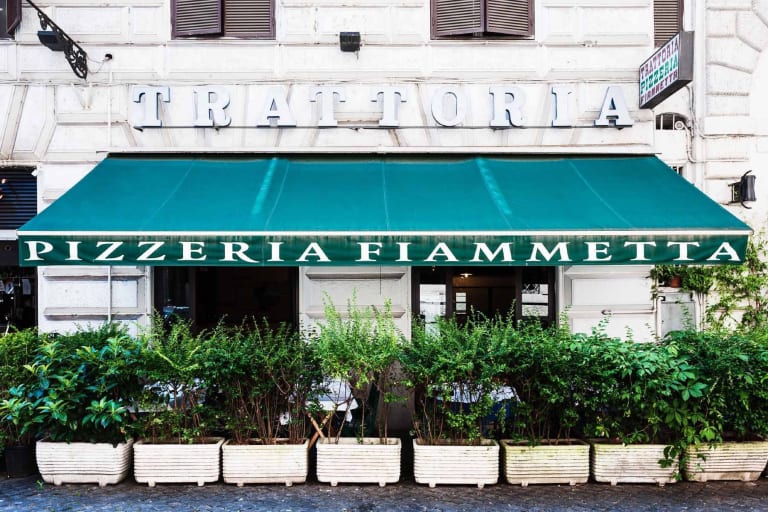
Close to Piazza Navona, at Piazza Fiammetta, 10, is Ristorante Fiammetta, a trattoria tucked away in a street of antique shops. It makes perfect sense, as this restaurant maintains all the quality, flavour and good workmanship of traditional Roman food.
You can eat both inside and outside in a cosy little terrace and for a not too exaggerated price, around 20 or 25 € per person. Totally recommended.
Take a tour of Campo de' Fiori
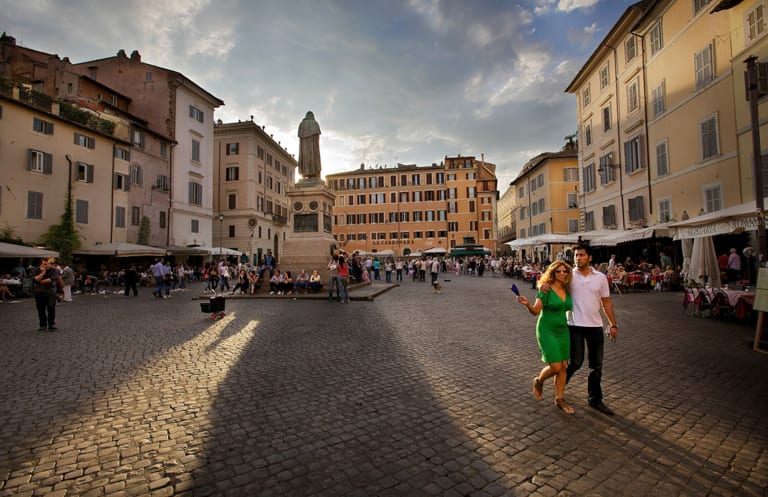
After lunch and coffee, return to Piazza Navona and walk south along Via della Cuccagna towards Palazzo Braschi, a former palace which is now known as the Museum of Rome. Continue to Corso Vittorio Emanuele and cross the street until you reach Via dei Baullari, at the end of which is Campo de' Fiori square.
During the day it is a bustling market and at night it becomes an area where you can go for a drink or enjoy a food tour of Campo de' Fiori. In the market you can find all kinds of food and even flower stalls, as it is really geared towards tourists, but you can still find some quality food products.
In the square of Campo de' Fiori public executions used to take place, so in the centre of the square there is a statue of the astronomer Giordano Bruno, condemned for his cosmological studies.
Visit the district of Trastevere

From Campo de' Fiori you are just a short walk from the last stop of the day: Trastevere. Head to the southeast corner of the square, just across the street from where you entered (I recommend using the statue of Giordano Bruno as a reference point). Go down Via dei Giubbanari to the narrow alleyway of Via dell'Arco del Monte. If you look down here you can see Ponte Sisto in the distance. Continue along Via dell'Arco del Monte and cross the bridge to the other side of the Tiber.
Turn left and follow Via del Moro to the end of the street, and on your right you will see Piazza di Santa Maria in Trastevere, the main square of this famous neighbourhood. It is home to one of Rome's most interesting tourist attractions, the iconic basilica of Santa Maria in Trastevere, which is definitely worth a visit to marvel at the impressive mosaics inside.
Trastevere is a wonderful neighbourhood to stroll around and enjoy the evening, whether it be around the Isola Tiberina or on the terrace of a bar. It has some of the most charming dining restaurants in Rome and you can also get to know it in detail by booking a tour of Trastevere.
Relax on the Gianicolo Terrace
After touring Trastevere, and if you still have time to watch the sunset, I recommend you to go up to the Gianicolo and enjoy the sunset over Rome. The Fontana dell'Acqua Paola, in front of which is the most popular viewpoint, is the direction to head, about 15 minutes walk from Piazza di Santa Maria in Trastevere.
If you are late or don't want to walk any further, I recommend relaxing with a Peroni and a pizza on the terrace of the pizzeria Ai Marmi, in Viale di Trastevere, 53-59. Although the atmosphere there is anything but laid-back, you will taste one of the most delicious pizzas in all of Rome, well deserved after a day of walking.
Day three: The grandeur of the Vatican and the Borghese Gallery
Day three starts with a visit to the Vatican and St. Peter's Basilica. There are guided tours that include entry to both and of course the dome, from where you'll be able to see the best views of the Roman city. You will finish this day in which art is the protagonist contemplating the wonderful works of art housed in the Borghese Gallery and strolling through its gardens.
Don't miss the Vatican Museums

Many people buy tickets for the Vatican Museums and the Sistine Chapel without queuing up as soon as they land in Rome, and no wonder. In this tiny country you'll find two of the most important places in the Western world, both for Art History and Catholic worship:
One of them is the Vatican Museums, a lavish museum where, in addition to an impressive Hall of Maps and the Vatican Picture Gallery, which exhibits works by Raphael, Caravaggio and Da Vinci, you can see the famous Sistine Chapel and gawk at the frescoes of Michelangelo's Last Judgement.
Here are some tips and useful information for your visit:
- I recommend you spend some time discovering everything this place has to offer. In addition to the aforementioned rooms, visit the Galleria Chiaramonti, full of Roman sculptures, go and see the 'Apollo of Belvedere' and the impressive 'Laocoon and his sons' in the Pio Clementino museum, the Rooms of Raphael, a series of rooms decorated by the artist himself, and the Chapel of Nicholas V, one of the jewels of the Vatican Museums that goes unnoticed by many visitors.
- Even if you are visiting the Vatican Museums on a 5-day trip to Rome and can take it easy, it is still essential to prepare your visit in advance. I recommend buying your tickets for the Vatican Museums online to avoid the exhausting queues at the entrance.
- If you prefer a guided tour, the official tour of the Vatican Museums allows you to skip the queue and have an expert guide at your disposal who will give you a very complete narration to understand everything you see.
- It is best to go as early in the morning as possible, even before opening time. How is this possible? With the early morning guided tour of the Vatican and the Sistine Chapel. In this experience you will tour the main rooms of the Vatican Museums in a small group, and at a time when tourists are not yet allowed to enter. Enjoying the Sistine Chapel in silence is, frankly, an experience that everyone should have. If you opt for an Early Bird tour of the Vatican, you'll be finished by 11:00 am at the latest, which means you'll have plenty of time to enjoy St. Peter's Basilica and the rest of the city.
- The Vatican Museums are closed on Sundays except for the last day of every month (a day to avoid, as admission is free and therefore crowds are massive). The official opening hours to the public are from 9:00 am to 4:00 pm, Monday to Saturday.
Visit St. Peter's Basilica

The other Western cultural must-see in the Vatican is, of course, St. Peter's Basilica: the most imposing church, both inside and out, in the entire world. Just seeing it from the outside, admiring the magnitude of St. Peter's Square, is spectacle enough, but going inside is like becoming a miniature and being transported inside a painting that you can walk around and feel. It will surprise you in every corner, regardless of your faith.
Before you visit, please note the following information:
- You don't need to buy a ticket to enter St. Peter's Basilica, but the queues are usually quite long, especially around midday. If you don't want to wait in line, take the Early Bird tour of the Vatican Museums to get there earlier, or take a guided tour of St. Peter's Basilica, again with an official Vatican guide, which allows you to skip the line.
- Once inside, you can marvel at the Baldacchino, Michelangelo's Pieta, and the tomb of Alexander VII, some of the jewels hidden in St. Peter's Basilica, plus of course its dome, which you can climb up to see in detail (and enjoy, on the outside, breathtaking views of Rome).
- If you want to do an in-depth visit on your own, don't miss the bronze statue of St. Peter, located on the right side of the central nave of the basilica. It is a bronze carving from the medieval period, whose foot is kissed or rubbed by the thousands and thousands of faithful who make the pilgrimage to St. Peter's Basilica every year.
- You can also visit the Vatican Grottoes, underground galleries where the remains of several famous popes are kept, including those of John Paul II. You can also see the tomb of St. Peter himself, located just below the main altar of the basilica.
- It is important to respect the dress code: shoulders and knees must be covered, so on this day you should wear long trousers and a jumper or scarf, and leave your cap or hat in your backpack.
When to visit St. Peter's Basilica? The truth is that you're going to find a lot of people in this visit whenever you go, so as I indicate in this itinerary, it's best to go after seeing the Vatican Museums, which are worth visiting with as few crowds as possible. Just avoid Wednesdays: St Peter's Basilica doesn't open until 1pm for the papal audience. The basilica is not open to the public on Sundays.
Enjoy the art in the Borghese Gallery
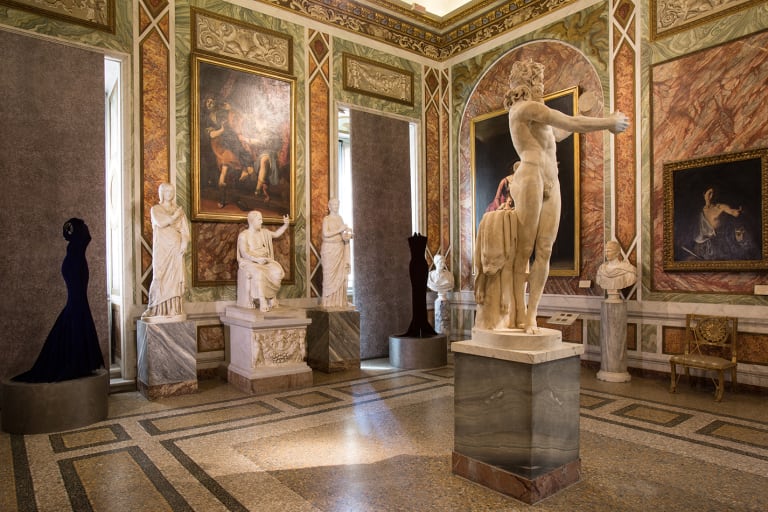
The Borghese Gardens are home to the world-famous Borghese Gallery, a museum where you can see an impressive collection of art with some of the most famous works by Caravaggio, Raphael, or Titian. Beyond paintings, the gallery is known for its catalogue of sculptures, which includes 'Apollo and Daphne', 'The Rape of Proserpina' and Bernini's 'David' and Canova's 'Victorious Venus'.
I recommend booking a guided tour of the Borghese Gallery, which will save you time and avoid the tedium of waiting in line.
At the end of your visit you can take a stroll down to Piazza del Popolo and enjoy a pleasant moment in the shade and even take in the beautiful views of Rome from the Pincio Terrace.
Day Four: Excursion to Florence and Pisa or Pompeii
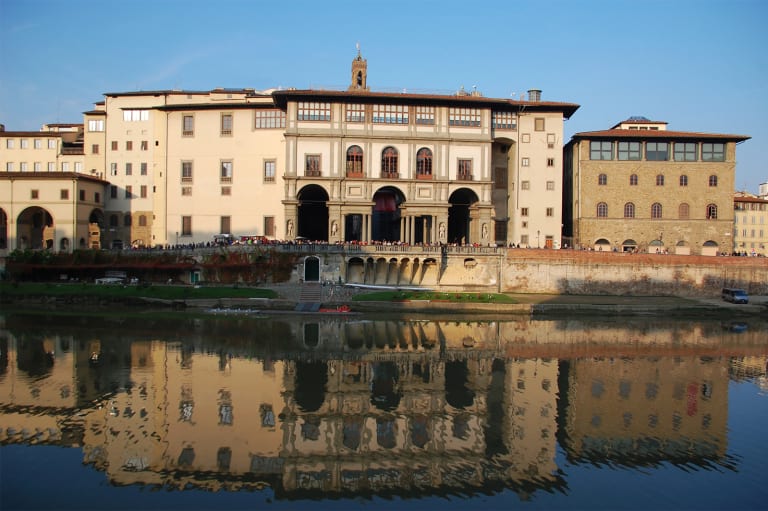
Since you are going to spend a few days in Rome and after seeing all the secret corners, why not visit one of the most beautiful cities in Italy on a day trip or go to one of the most famous ruins in the world?
I'm talking about, of course, a trip to the city of Florence, with its incredible cathedral, and on the way to Pisa to see its famous leaning tower, or explore the ruins of Pompeii where one of the most faithful images of life in the ancient world is preserved. Choose your own adventure!
Discover Florence and Pisa
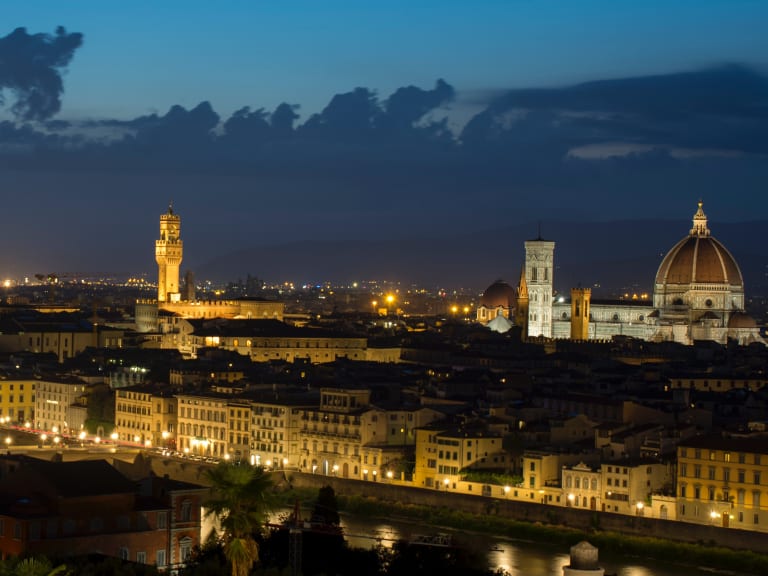
This tour not only takes you to see the most unforgettable sights of Florence, but also passes through Pisa to see the iconic leaning tower that has made the city so famous.
A local guide, an expert in the history of both cities, will take you to see all the must-see sights: Florence's Duomo square, Palazzo Strozzi, Ponte Vecchio, and the Galleria dell'Accademia, where you can see Michelangelo's famous David (if you choose this option when booking the experience), among others.
The full day excursion to Florence and Pisa from Rome lasts approximately 14 hours and is priced at £125, and is a perfect way to include a city break in your trip to Rome as you don't have to organise anything, just meet your guide at the meeting point and start enjoying yourself. If you want to prepare this tour on your own or have other options to visit Florence, I recommend you to read this article where I tell you everything you need to know: Day Trips to Florence from Rome.
Visit Pompeii
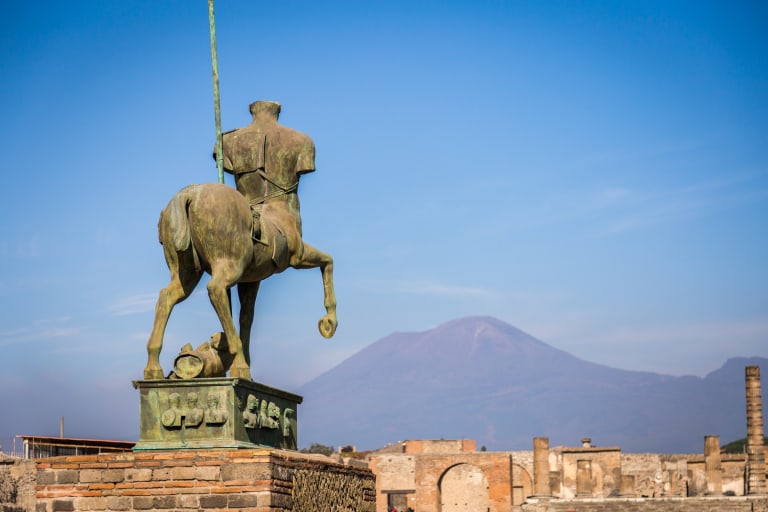
The other option for a day trip from Rome is to book a tour to Pompeii and discover the history of this place and what happened there almost two thousand years ago.
On this day trip to Pompeii and Vesuvius from Rome you will climb Vesuvius, an active volcano with breathtaking views from its crater. Afterwards you will be taken for lunch at a Neapolitan pizza restaurant and in the afternoon you will tour the ruins of Pompeii and all its archaeological sites.
To discover other excursions to Pompeii or to learn more about what not to miss once you are there, I recommend you read this complete guide to this experience: Day Trips to Pompeii from Rome.
Day Five: Discover Rome's hidden gems and say goodbye to the city in style
Finish your trip by exploring some of Rome's hidden gems that you might not have time to see on a shorter trip. However, they are no less interesting to visit.
Visit the Castel Sant'Angelo
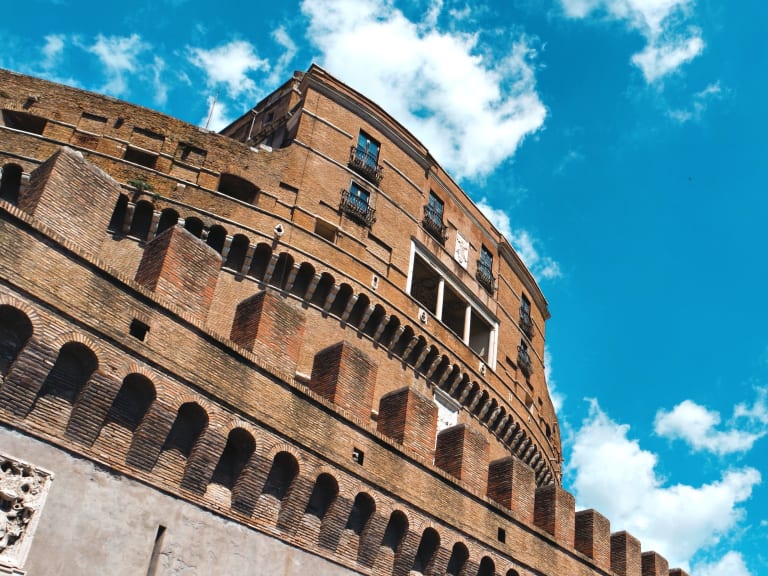
A ten-minute walk from Piazza Navona is the Castel Sant'Angelo, across the Tiber from the beautiful Ponte Sant'Angelo, one of Rome's most beautiful bridges. It is a majestic building that was built as a mausoleum for Emperor Hadrian, and throughout its history has served as a fortress for popes and nowadays as a museum for visitors.
It is worth spending the morning visiting this emblematic building and going up to its rooftop, from where you can see Rome from a different perspective. To avoid queues, you can buy your Castel Sant'Angelo tickets online with audio guide or if you prefer you can take a tour of the Castel Sant'Angelo.
If you decide to visit it on your own, I recommend you read this article to know beforehand the most interesting things about this place: Castel Sant'Angelo in Rome: Tickets and Tours.
Stroll along the Appian Way and the Catacombs
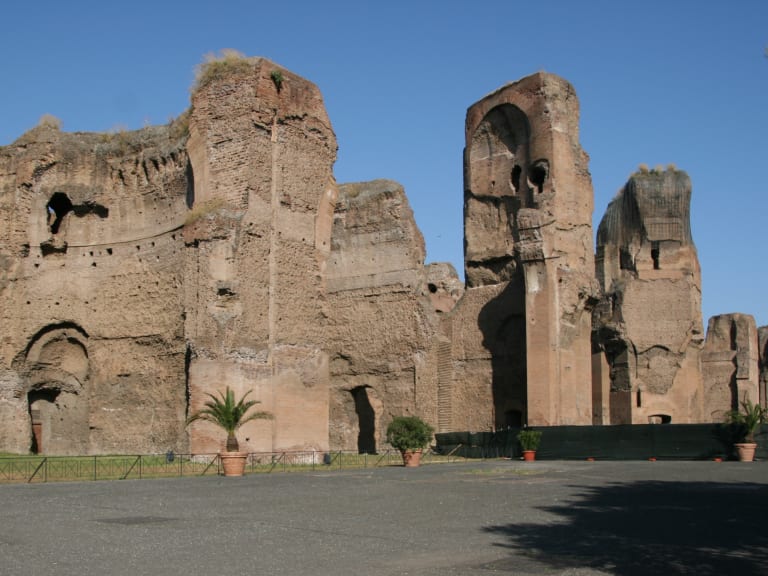
The Appian Way is the ancient Roman road that connected the city with the southern sites for the transport of troops and goods. It is still fairly well preserved and along its route you can visit an archaeological park full of interesting sites, the Parco Regionale dell'Appia Antica(one of the most beautiful in Rome).
Walking along the Appian Way is a great way to enjoy another side of Rome away from the hustle and bustle of the centre. My recommendation is to go on Sunday when it is closed to traffic, as it takes on a very special atmosphere. Start the walk at the visitors' centre until you reach the tomb of Cecilia Metella and the Circus of Maxentius. On the way, if you feel like it, you can visit the Catacombs of Rome: either the Catacombs of St. Callixtus or the Catacombs of St. Sebastian. The Catacombs of St. Callixtus are the most popular as they offer a more extensive tour and are the resting place of the first sixteen popes, as well as some Christian martyrs.
If you decide to try this experience, you should know that it can only be done by booking a guided tour of the catacombs and the Appian Way Read the complete guide to the Catacombs of Rome, where I tell you everything you need to know before booking a tour: Catacombs of Rome Tickets and Tours.
Take a lunch break
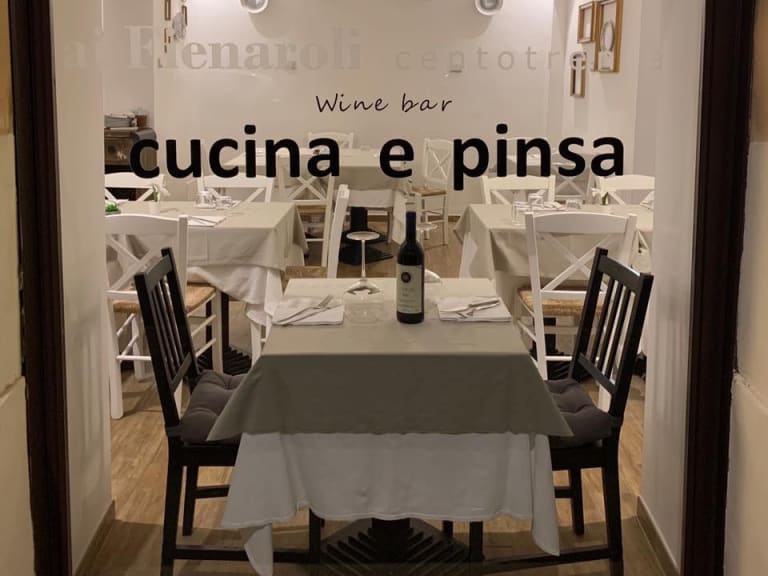
For lunch, I recommend Ai Fienaroli on Via Piemonte, 125. On their menu you can find some delicacies such as bluefin tuna tartar with crusty bread and fennel cream, a delicious carpaccio of sea bass with pistachios and black truffle, and they also have some great artichokes with beans.
Although the price is around €40 per person, it's worth a treat on your last day in the Eternal City.
Look for the lock of the Knights of Malta
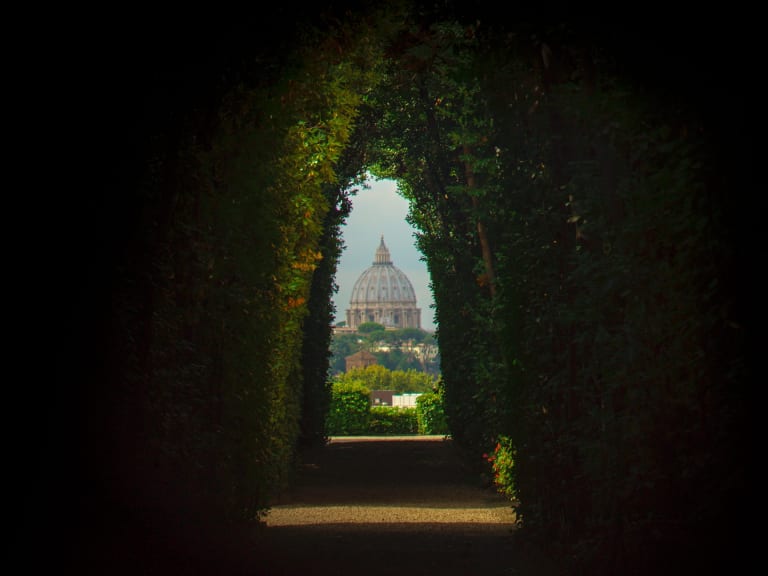
At the top of the Aventine Hill, the southernmost hill in Rome, there is an area of lavish mansions and gardens that hides a secret: the Garden of Orange Trees, known by the locals as the Giardino degli Aranci.
It is a park where you can find a gate through whose lock you can see, in the distance, the dome of St. Peter's Basilica, framed by trees. Apart from this curiosity, the area is a delight to stroll around while you enjoy the smell of the orange trees and, in the evening, admire the sunset from one of the locals' favourite viewpoints. Consider booking a tour of hidden Rome to see this and others that are off the beaten tourist track.
From October to February, the park is open from 7am to 6pm, from 7am to 8pm from March to September and from 7am to 9pm from April to August. I recommend getting a spot at the observation deck about an hour before sunset to enjoy the sunset and say goodbye to the amazing journey you are about to experience.






